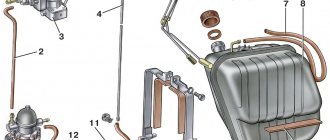VAZ 2106 owners know firsthand how many problems this car can cause. At the same time, a particularly large number of troubles are associated with the fuel pump: it either pumps, or does not pump, or becomes clogged with debris, or refuses to work for unknown reasons. Therefore, it is necessary to learn in advance about all the intricacies of the operation of the gasoline pump and be able to eliminate any malfunctions that may arise.
- Operating principle
Video: design and operation diagram of a gasoline pump
- Signs of a malfunctioning gasoline pump
What to do if the fuel pump does not pump
- The pump does not pump when hot
- Why does the pump hum but not pump?
- For what reasons can the fuel pump on the “six” fail?
- Drive faults
- How to remove a pump from a car
Video: dismantling procedure
- Video: fuel pump repair
- Video: how to quickly and correctly replace the pump
- Installation of an electric fuel pump
Video: electric pump for the “classic”
Fuel pump VAZ 2106
A car fuel pump is considered the most important element of the entire gasoline supply system. Actually, the pump is necessary in order to pump fuel from the gas tank to the carburetor. After all, it is in the carburetor unit that the air-fuel mixture is formed, which is then supplied to the engine.
The fuel pump supplies fuel from the tank to the engine through special hoses.
Principle of operation
The main task of the fuel pump is to generate excess pressure in the fuel system under any engine operating mode. It is necessary to ensure that there is always a sufficient amount of gasoline in the carburetor float chamber.
Video: design and operation diagram of a gasoline pump
Which fuel pump is better for the “six”
The standard equipment of the “six” is a gasoline pump produced by DAAZ (Dimitrovgrad Automobile Unit Plant). In terms of its structure, it is a mechanical unit, which is equipped with a diaphragm drive. Three diaphragms are built into the design of the DAAZ fuel pump to ensure uninterrupted operation of the device.
Find out what to do if the salon smells of gasoline: https://bumper.guru/klassicheskie-modeli-vaz/poleznoe/zapah-benzina-v-salone.html
The performance of a fuel pump of this brand is 60 liters per hour (on free drain). This volume is quite enough for optimal operation of the entire fuel distribution system on the VAZ 2106.
Initially, the “six” was equipped with DAAZ brand fuel pumps
A modern analogue of DAAZ is considered to be a petrol pump of the Pekar brand produced by the fuel equipment plant in Saratov. This pump has the same performance (60 l/h), but is considered more reliable due to its high tightness and resistance of the membrane elements to oil.
“Pekar” can be installed on a VAZ 2106 of any year of manufacture, but it became standard after 1990.
The Pekar fuel pump has the same performance as the DAAZ, but it is more modern and reliable
Thus, DAAZ and Pekar are the optimal equipment for the VAZ 2106 system, which allows the car to function without interruptions and breakdowns.
The gasoline pump on the VAZ 2106 is located under the hood. The device is fixed on the left side to the engine cylinder block. Fastening is carried out with studs with the obligatory use of a thermal spacer and an adjusting shim. This arrangement is very convenient, since if necessary, you can quickly find, remove and repair or replace the faulty part.
The fuel pump is located on the cylinder block on the left side
Diesel engine power supply system
High pressure fuel line between pump and rail
Removal and installation
1. Stop the engine and wait at least 30 seconds. During this time, the fuel pressure in the power system should decrease.
2. Remove the decorative engine cover.
3. Remove the air conditioning compressor.
4. Unscrew the fastening bolt (1) of the high pressure fuel line bracket.
Note
: Tightening torque: 10 N∙m.
5. Unscrew the union nut (2) securing the high-pressure fuel line to the fuel rail.
Note
: Tightening torque: 24 N∙m.
6. Unscrew the union nut (3) securing the high-pressure fuel line to the high-pressure fuel pump.
Note
: Tightening torque: 28 N∙m.
7. Remove the high pressure fuel line (4) and close all open holes (to prevent contamination of the fuel system) using a set of suitable plugs.
8. Installation is carried out in the reverse order of removal.
9. After completion of the repair:
- Perform the fuel system priming procedure.
- With the engine running, check the fuel system for leaks.
Signs of a malfunctioning gasoline pump
Interruptions in the fuel supply to the engine or engine failure to start are not always associated with malfunctions of the fuel pump itself. Of course, these signs are a clear fact that there is a failure in the fuel system, but in order to find out their cause, it is necessary to carry out diagnostics. However, according to statistics, most often problems arise precisely because of the fuel pump.
The following signs can be identified that indicate a possible pump malfunction:
- the engine does not start or does not start the first time;
- the engine “troubles” at high speeds and runs jerkily;
- humming sound when driving;
- noticeable loss of vehicle dynamics.
About other causes of engine failure: https://bumper.guru/klassicheskie-modeli-vaz/poleznoe/ne-zavoditsya-vaz-2106.html
What to do if the fuel pump does not pump
The most common sign of a pump failure is a lack of pressure in the fuel system, that is, the fuel pump simply does not pump fuel. The cause of such a breakdown may be:
- natural wear and tear of pump elements;
- cracks and ruptures in diaphragms;
- diaphragm spring extension;
- clogged valves;
- severe contamination of filter elements;
- cracks in the pipes and hoses of the fuel system.
It is quite easy to see damage to hoses during a normal visual inspection. In all other cases, you will need to remove the pump from the machine and disassemble it in order to identify the faulty element and replace it.
In many cases, it is more advisable not to repair the old fuel pump, but to replace it
The pump does not pump when hot
In some cases, the pump on a VAZ 2106 may malfunction only in specific cases - for example, it works properly when starting the engine, but stops supplying fuel when it’s hot.
This is due to the fact that the gasoline in the tank and throughout the fuel system does not have time to cool. As a rule, the problem lies not in the pump itself, but in the drain pipe or fuel receiver. It will be necessary to check these elements so that the pump can operate smoothly.
remove the gas tank, check the blue drain tube for constriction, remove the fuel receiver, and also check if it is clogged
Artificial intelligence
https://otvet.mail.ru/question/60646959
Why does the pump hum but not pump?
VAZ 2106 owners may encounter a different kind of problem: the fuel pump turns on and hums, but does not supply fuel to the engine.
The pressure in the VAZ 2106 fuel system should be equal to 3 atmospheres. You will need a pressure gauge to check this indicator. If the pressure is significantly lower, the fuel pump requires replacement.
Gasoline may not flow into the engine even if the fuel pump is working. The reason in this case lies in the lack of tension. If you do not hear a characteristic buzzing sound when you turn the key in the ignition switch, then the problem lies in the relay, wires or connectors.
A working fuel pump should create a pressure of 3 atmospheres in the fuel line.
For what reasons can the fuel pump on the “six” fail?
As practice shows, the DAAZ fuel pump is more susceptible to wear and tear, and therefore fails much faster than the Pekar brand pump. However, for both models, the following reasons are equally sources of breakdowns:
- Gasoline pump rod. During vehicle operation, the pump rod inevitably shortens (natural wear). In this regard, the device stops supplying the required amount of gasoline to the engine. Only VAZ 2106 carburetor models are equipped with rod fuel pumps.
- Valve mechanisms. The valve is one of the fastest-wearing components in a pump. In this case, most often the sealing ring on the valve fails, which leads to incorrect operation of the opening mechanism.
- Low quality fuel. Gasoline used to power the engine of questionable quality can quickly damage the electric fuel pump. Electric pumps are installed only on injection models of the VAZ 2106.
To extend the life of the pump, you must:
- refuel only at proven gas stations;
- periodically clean the gas tank from dirt and impurities;
- monitor wear of pump parts;
- listen to the operation of the pump and carefully monitor the dynamic characteristics of the machine.
How to check a mechanical fuel pump VAZ 2108/2109
Checking a mechanical fuel pump involves determining its performance, i.e. measuring the amount of fuel pumped per unit of time. And according to the characteristics of the device, it should be at least one liter per minute. To determine it, you will need an assistant, as well as the following tools and tools:
- screwdriver with Phillips bit;
- a piece of fuel hose;
- 2 empty plastic bottles;
- 1.5 liters of gasoline;
- watch with stopwatch.
Sequencing:
- Using a screwdriver, unscrew the screw on the outlet fitting clamp, loosen it and remove the fuel hose.
- Pour gasoline into a plastic bottle. We lower the free end of the fuel hose (removed from the outlet fitting) into the bottle to the bottom. Through it, gasoline will be sucked into the carburetor when the fuel level in the float chamber decreases.
- We put the end of the prepared hose onto the outlet fitting of the fuel pump. Place the other end into an empty bottle.
- We ask the assistant to start the engine, start the stopwatch. If the car has a tachometer, stick to 2000 rpm. If it is not there, we rely on hearing.
- When the engine starts, gasoline should flow from the pump outlet into the container. After a minute has passed, ask the assistant to turn off the engine and measure the amount of gasoline pumped. If the volume of fuel in the bottle is less than a liter, the fuel pump must either be repaired or replaced.
Further diagnostics should be aimed at identifying the faulty pump element. To carry it out you need:
- screwdriver with Phillips bit;
- wrenches 10 and 13;
- caliper (ruler).
Check procedure:
- First of all, we check the operation of the valves. Unscrew the screws of the clamps securing the fuel hoses to the pump fittings. We remove the hoses. We put our finger (palm) against the outlet fitting, plugging it. Press the manual pumping lever several times. At the same time, the pump should make slurping sounds, and air pressure should be felt at the fitting. We check the intake valve in the same way. When you press the pumping lever, your finger should be sucked into the fitting. If there is neither pressure at the outlet nor vacuum at the inlet, either the valves or the diaphragms are faulty.
- At the next stage, use a 10mm wrench to unscrew the fuel pump cap. There is a mesh filter underneath. We assess his condition. The mesh must be clean and have no signs of deformation. If necessary, you can clean it with a jet of air, an old toothbrush and gasoline.
- Now let's check the apertures. Unscrew the screws securing the upper and lower parts of the housing. There are only 6 of them. Remove the body and remove the rod with the diaphragms. There is a nut at the top of it. We unscrew it with a 10mm wrench, remove and disconnect the diaphragms. We assess their condition. If they have ruptures or cracks, the diaphragms need to be replaced. They are unsuitable for further use.
- The last step is measuring the length of the pusher. To get to it, you need to disconnect the lower part of the pump housing from the accessory drive housing. Unscrew the two nuts with a 13mm wrench and remove the lower part. Under it there is a textolite thermal spacer in the form of a cone, the top of which goes into the drive housing. There should be thin paronite gaskets on its mating surfaces. Remove the spacer with gaskets. There is a pusher inside it. We take it out and measure the length. It should be 82.5 mm (minimum acceptable - 81.8 mm). If the pusher is worn, it needs to be replaced. Wear leads to a decrease in the amplitude of movement of the rod with diaphragms, due to which its performance is significantly reduced.
Fuel pump drive
The fuel pump drive for the “six” is a rod. Due to its translational movement of the pusher, gasoline is sucked in.
This movement is provided by the actuator cam and diaphragm return spring. When the membrane moves, pressure is created in the system. Immediately after the diaphragm stops, the exhaust valve closes, so the fuel flows into the opening inlet valve. Through it, with a new forward movement of the rod and membranes, the fuel is transferred to the carburetor.
The operation of the fuel pump is controlled by a pusher (2), which moves under the action of an eccentric located on the engine camshaft
On the VAZ 2106, to facilitate work with the fuel system, a lever is installed to increase the pressure in the system. With its help, the driver can artificially create pressure up to 30 kPa.
Drive faults
One of the most common causes of fuel pump failure is damage to the rod. Diagnosing this malfunction is very simple: its main symptom is the inability to accelerate the car even on a flat, straight road.
The rod is the steel rod at the base of the pump. During long-term use, it wears out, which leads to a malfunction in the drive part. As a rule, if the rod is worn out or bent, it is impossible to accelerate the car to a speed above 90 km/h.
The fuel pump rod is made of wear-resistant steel alloys, but during prolonged use it wears out and causes the part to malfunction
Replacing the rod mechanism involves simultaneously replacing two gaskets. When inserting a new rod into the pump body, you need to ensure that it protrudes beyond the spacer by a distance of no less than 0.8 mm and no more than 1.3 mm. That is, the optimal protrusion option is 1 mm.
In order to ensure this overhang, you will need to select gaskets of the required thickness. If the rod overhang is less than 0.8 mm, the engine will begin to experience difficulties when accelerating, and if it exceeds 1.3 mm, the diaphragms may break.
Read about the malfunctions of the VAZ-2106 GBZ: https://bumper.guru/klassicheskie-modeli-vaz/grm/poryadok-zatyazhki-golovki-bloka-cilindrov-vaz-2106.html
Cleaning the mesh in the non-collapsible fuel pump of the Skoda Octavia A5
My car is a late 12-year model and most of these Skodas have a dismountable fuel pump. The Czechs were helpful to me - I do NOT have a collapsible one. Well, okay. Doesn't really float. I did everything according to the reports from the drive. There is nothing particularly complicated.
In the article I will write what is needed to clean the mesh, steps with nuances and the photo report itself with explanations. Cat. I will post the numbers of the mesh for the collapsible pump in a separate article.
So, to work you need:
- hammer, - screwdriver, - plastic cup 2-3 pcs. - rags, - carburetor cleaner, - a toothbrush for cleaning, - a vacuum cleaner, - well, and cardboard where to put the fuel pump
STEPS:
1. I pulled back the sofa, see photo on how to do it correctly. We lift the sofa up and pull it towards the chair. We lift the carpet and see a round plug.
2. The plug contains a rubber plug with wires, which can be easily removed. Let's take it off. We put our finger in there and take out the completely round plug, we are not afraid of anything, nothing will break, it comes out easily.
3. Cover with rags around the gas pump so that gasoline does not accidentally get on the carpet, and so that it does not stink later.
4. Next, disconnect the plug with the wires. It was difficult for me to remove it. There is a little red thing, like a latch, lift it up and pull the plug up. I didn’t want to act, but then I did. Then I took the compartment back and took it off again and broke the little thing, now the plug can be removed without problems and is not fixed. Here, the main thing is to remove it carefully.
5. Next. Let's go get behind the wheel. We start the car and remove the pressure in the system, run the engine for 20-30 seconds and stall on its own, start it again and it stalls immediately.
6. Now let's go remove the blue hose first. How can I remove it without breaking anything? The blue and black hoses have chips that hold the hose. In the chip itself there is a button, like a stopper, small buttons, difficult to see but possible. We press the button and pull the piece with the hose up. That's it, she's in her hands.
7
Black hose, ATTENTION! We remove it in the same way and substitute a plastic cup, because gasoline will flow out of it under pressure. No gasoline flows from the blue hose
8. Place the glass under the gasoline and drain. It drains a little, 150 grams.
8.a. We make a mark where the arrow is.
9. Then take a hammer and screwdriver, and tapping counterclockwise, unscrew the ring. Don’t forget, there is an arrow where the pump was originally located, let’s mark it so that we can put everything in the same place later. Marked with a screwdriver, see photo.
10. The ring was removed. The pump slowly rises up, about 2-3 cm. There’s nothing wrong with that. Yes, I almost forgot. When we hit the ring with a hammer to unscrew it, dirt and dust still fly from the sides onto the pump itself. There is nothing terrible, you can immediately wipe it after removing the ring so that nothing gets inside the tank.
11. Remove the ring, carefully remove the pump, lift it up
It is important that the gas tank is almost at minimum, it’s easier this way
12. Raise the fuel pump carefully. Do not touch the fuel level float; it is located in the direction of the passenger seat behind the driver.
13. As soon as the float rests against the upper wall of the tank, bend the pump in the opposite direction and remove the pump without touching the float. Along the way, anyone with straight arms, without rushing, will understand the meaning of the matter.
14. I removed the pump, poured gasoline into the machine from the glass of the pump itself. We look inside the glass, everything is clean, except for a light coating on the walls of the glass, like pollen sediment. The filter itself is dark in color. No clogging or soot was found during disassembly. Cleaned the fuel pump with carburetor cleaner. Under pressure, I cleaned the mesh inside with a cleaner - the walls, all the mechanisms, wiped it with a rag where I could reach. The filter itself became visually cleaner, it drained all the dirty slurry into a glass, see photo. Then I put everything back in its place, in reverse order. The condition of the fuel pump mesh is good. Although I found threads where people generally tore off these nets and don’t worry, they drive without nets at all.
Actually, that’s all - use it for your health).
Collections on the topic:
Skoda 1.6 bse stalls while driving and does not start immediately - treatment The steering wheel icon on the Skoda panel is constantly on - what is it and how to fix it
The Skoda started to warm up - what could happen?
Lost idle speed - reasons and how to restore it yourself (from the manual)
Fuel pump malfunction on Skoda or another global scam!
It blows cold from the air duct - Skoda Octavia 2011, 1.6 MPI
Speed jumps on Skoda
The central locking button is faulty
Steering
- Replace steering rack bushing on Chevrolet TrailBlazer
- How to change the power steering of a Chevrolet TrailBlazer with your own hands
- How to Change Power Steering Fluid on a Chevrolet TrailBlazer
- Change the power steering fluid on a Chevrolet TrailBlazer
- Replacing the steering shaft driveshaft of a Chevrolet TrailBlazer with your own hands
- How to change the steering shaft spider on a Chevrolet TrailBlazer
- How to change the oil in the power steering of a Chevrolet TrailBlazer
- Change the tie rod end of a Chevrolet TrailBlazer with your own hands
- Installing the Steering Shaft Bearing on a Chevrolet TrailBlazer
- Installing the Chevrolet TrailBlazer steering rack boot
- Change the steering rack of a Chevrolet TrailBlazer with your own hands
- Do-it-yourself Chevrolet TrailBlazer steering linkage installation
- Change the steering ends of a Chevrolet TrailBlazer yourself
- Remove the Chevrolet TrailBlazer steering wheel yourself
- Do-it-yourself repair of Chevrolet TrailBlazer front suspension arms
- Change the rack seal on a Chevrolet TrailBlazer with your own hands
- Replacing a Chevrolet TrailBlazer kingpin with your own hands
Reason #3 – Lack of spark
To start the engine, two conditions must be met:
- Setting something on fire is fuel, we’ve already dealt with that;
- To set fire to something means the presence of a spark. Let's talk about this.
It is necessary to check sparking at the spark plug electrodes.
To do this, unscrew the spark plug and put an armor wire or ignition coil on it. We place the threaded part of the spark plug on the engine body and “twist” the starter.
If there is a spark, then everything is in order, if not, then there may be several reasons:
- The spark plug has failed.
If there was only one, the engine would fail, but since it won’t start, we check all the others. Carbon deposits, oily deposits, damaged or melted electrodes may be the cause. - Armored wires.
Due to old age, their insulation may become damaged, part of the current will go to the “side”, and there will be no spark. - Ignition coil or individual ignition coils.
In the first case, it may be a real problem starting the engine. In the second, all the coils must be “covered with a copper basin” at the same time, which is unlikely. So let's move on. - Ignition module.
If there is no spark on all the candles, it means that the “end” has come for him.
Welcome to VAZ.EE+ Extended Edition
Since May 2013, our portal has expanded the thematic sections of the forum for the exchange of experience: subforums Americans, Koreans, Germans, French, Japanese have been added, due to the increase in the fleets of our visitors.
In addition to changing the style, our Chat, Mail, Entertainment and photo/video sections, Literature have become built-in and do not require separate registration. In addition, there are other useful and pleasant innovations that you can all familiarize yourself with when visiting the portal.
You can contact the administration with questions and suggestions in a special section of the forum or through the feedback form.
- literature Articles
- Library
- Jokes
- Cars
- Gallery
- Automobile
- Help
- Search
- Users
- Reputation
- Forum home
- Experience exchange
- Engine and transmission
- print version
- Download/Print theme
- Display Modes
- Switch to: Tree-like
- Standard
- Switch to: Linear
Replacing diaphragms and valves
To replace these elements, you need to perform a few simple manipulations:
- Hold the diaphragm rod by the shank.
- Unscrew the nut.
- Remove all components of the diaphragm assembly. Be sure to remember how they are located.
- Reassemble in reverse order. The holes for the bolts must match. The tongues should be directed in one direction.
- Next you will need to remove the valves from the seats. First you need to open them with a needle file.
- Be sure to cap it after installing a new valve.
If the valves are not secured, they may fall out during operation and, at best, cause a failure of the fuel supply system. During assembly, make sure that the hole in the spacer is opposite the pump lever. In this case, it will be possible to detect a leak much faster.
Article: 21010-1106166-00more, additional articles: 21010110616600, 2101-1106166hide
Order code: 003329
In stock Available for order – >10 pcs. Data updated: 05/27/2021 at 19:30
Order code
003329 Articles 21010-1106166-00, 21010110616600, 2101-1106166 Manufacturer LADA Catalog group: .. Engine power Width, m: 0.005 Height, m: 0.005 Length, m: 0.08 Weight, kg: 0. 012
Product reviews
Where is it used?
Certificates
Reviews
There are no reviews for this product yet.
Write a review
Articles about the product
- “Crystal” vases: “Classic”. Do you remember how it all began? April 16, 2013 Today, the next article in the series “Crystal VAZs or typical breakdowns of domestic cars” is dedicated to the “classics”: VAZ-2101, 2103, 2104, 2104, 2105, 2106 and 2107. These cars have been driving along our roads for decades and, despite all the shortcomings that we will talk about, their popularity is still high.
- “Crystal” VAZs: “Eight”, Kalina, Priora
March 26, 2013 A series of articles ““Crystal” VAZs, or typical breakdowns of domestic cars” talks about typical problems and malfunctions of cars produced by the Volzhsky Automobile Plant. Today we will talk about the front-wheel drive Samara family, as well as its modern analogues. - “Crystal” VAZs or typical breakdowns of domestic cars
March 9, 2013 In the series of articles “Crystal” VAZs or typical breakdowns of domestic cars” we will tell you about the typical problems that occur when operating cars of the Volzhsky Automobile Plant. In this article we will talk about the VAZ-1111 (“Oka”) car.
- Fuel pump pusher VAZ-2101-2108 AvtoVAZ Article number: 21010-1106166-00, 21010110616600, 2101-1106166 Order code: 003329 75 ₽ or place an order by calling 8 800 6006 966
Availability of goods in warehouses and stores, as well as the price of the goods is indicated on
27.05.2021 19:30
.
Prices and availability of goods in all stores and warehouses are updated once an hour.
If there is a sufficient quantity of goods in the store you need, you can buy it without pre-ordering. Internet price
– valid when ordering on the website or through a call center operator by phone
8-800-600-69-66
. Subject to sufficient quantity of goods at the time of order.
Price in stores
– retail price of goods in store sales areas without pre-order.
The period for moving goods from a remote warehouse to the warehouse of an online store.
The parts data presented on this page is for informational purposes only.
e47c4aca63414f58603952b95ff4db69
Add to cart
Available to order:
Order quantity:
Product successfully added to cart
!
- Like
- I do not like
Chepa Jul 21, 2010
What to do if the car does not start after replacement
Sometimes the car doesn't start right away because the fuel pump needs to restore pressure. You should wait - turn on the ignition for 5-10 seconds. The instrument panel should light up. Next you need to crank the engine with the starter. The first attempt may not be successful - you should wait a minute and try again.
If the method does not give positive results, then the reason lies in other factors. It is possible that an error was made during the assembly or connection of the pump. Or there is a malfunction in the new fuel module. It is possible that the problem is in the car's security system or in the lock.
Features of the design and location of fuel pumps VAZ 2108/2109
The DAAZ gasoline pump has a simple mechanical design. It includes:
- a body consisting of an upper and lower part;
- lid;
- mesh filter;
- valves (inlet and outlet);
- diaphragms (3 pcs) with spacers;
- the rod to which the diaphragms are attached;
- return spring;
- manual pumping lever.
The VAZ 2108/2108 mechanical fuel pump is located in the engine compartment of the car and is installed on the auxiliary drive housing (in front of the ignition distributor). It is driven by the camshaft through a cam mechanism and a rod (pushrod). The camshaft rotates an eccentric, which transmits force through a pusher to a balancer at the bottom of the pump housing. The latter raises and lowers the rod with the diaphragms. Thus, a vacuum is formed at the pump inlet, and pressure is formed at the outlet. Valves located in the device body are responsible for its maintenance.
The VAZ 2108/2109 mechanical fuel pump is located on the auxiliary drive housing
On injection VAZ 2108/2109, the fuel pump is not a separate device, but an element of the fuel module. It also includes:
- plastic storage cup;
- coarse mesh filter;
- fuel level sensor.
The module is located in the car tank. Its lid (base) is located at the top of the container. You will find it by removing the back seat and peeling back the carpet.
The electric fuel pump in the injection VAZ 2108/2109 is located in the car tank
Structurally, the fuel injection pump VAZ 2108/2109 is an electric motor with an impeller on the shaft, which, rotating, pumps gasoline, creating a vacuum at the inlet fitting and pressure at the outlet. The pump is powered from the machine’s on-board network, protected by separate relays and a fuse.
Design of the electric fuel pump VAZ 2108/2109
Reasons for lack of submission
After making sure that there is fuel, that the filters are clean and that the fuel line is clear, you can begin diagnosing the pump. The reasons for its failure can be caused by:
- natural wear and tear from long-term use;
- violation of the integrity of the diaphragm;
- stretching of the spring and loss of its elastic properties;
- accumulate dirt on the valves;
- loss of filter capacity due to clogging;
- violation of the tightness circuit, etc.
The owner of a VAZ 2106 is faced with a choice - which path to take in order to restore the functionality of the pump.
The first option is the simplest and most reliable
, but expensive in terms of cost. Any decent service station has equipment that, in a minimum amount of time, will not only measure the pressure at the inlet and the vacuum at the outlet of the fuel pump, but also identify the part causing defects in the operation of the equipment. Second
The option is not the simplest, not so fast, but practically free, except for the time spent on it - do all the diagnostic and repair work yourself in the garage.
{banner_content}











